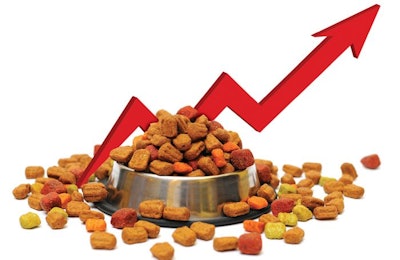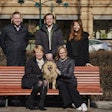
Global sales of all pet care products and services, including pet food, increased 14 percent from 2012 to 2017, representing US$13 billion in value growth. That means sales reached US$109 billion last year, according to Paula Flores, head of pet care research for Euromonitor International.
Flores, presenting the data during a webinar, “Top pet food trends for 2018,” commented that this growth was healthier than that for most packaged goods, including human food. Asia Pacific is now the third largest pet care region, after North America and Western Europe, barely edging out Latin America in fourth place. Eastern Europe, Australasia and Middle East-Africa follow, with much smaller shares.
Specific to pet food, dog food captured the largest share of pet care sales by far in North America, Latin America and, to a lesser extent, Asia Pacific, and was about even with cat food in Western Europe, where cats tend to be more popular than in other parts of the world. Cat food had the largest share in Eastern Europe, Flores said.
US market still dominates pet care and pet food sales
As a clear reminder of the US pet care market’s size, Flores presented a pie chart showing US sales in relation to overall global sales. No surprise, it’s a significant slice of the pie, at about 44 percent in 2017. What may be even more remarkable, given the rapid growth of sales in other countries and regions, such as China, Thailand and India in Asia, and Brazil and Mexico in Latin America, is that the US market’s share of global sales has remained about the same for the past 10 years.
That’s despite the fact that pet food sales in the US are growing by only a single digit percentage (2 to 4 percent), and growth of pet products other than pet food is less than 2 percent. The US market’s sheer size allows it to continue to dominate, even as other countries and regions grow at a greater rate.
Looking ahead, Flores projected pet food sales in the US to continue to increase between 2 to 3 percent a year through 2022. In terms of overall pet care sales by region, Asia-Pacific will enjoy the highest growth, from about 7.5 percent in 2017 to more than 9 percent in 2022. Sales in Latin America will continue to increase by about 5 percent a year, with Middle East-Africa also seeing 4 to 5 percent growth a year (though from a much smaller base).
Eastern Europe’s growth has slowed; it was about 3.5 percent in 2017, Flores’ data showed, and may top 4 percent by 2022. Growth in North America will remain at about 2 percent, with Western Europe and Australasia pet care sales bringing up the rear at 1.5 percent and 1 percent, respectively.
Clean label continues to dominate trends
Flores also presented data showing global and US sales of clean label packaged human food, relating to “clean label” as one of the key pet food trends for 2018, identified by her webinar co-presenter, Lindsay Beaton, managing editor of Petfood Industry. Because trends in pet food are so closely aligned to those in human food, Flores’ data was intended as a reference point, though she didn’t define or explain how Euromonitor measured clean label sales. For example, did they track sales of human foods with specific label claims?
Regardless, the data provides some indicators as well as validation of clean label as a reigning trend. In 2016, global sales of clean label human foods approached about US$180 billion dollars and are projected to exceed $200 billion by 2021, a 7 percent increase. In the US, 2016 sales were about US$75 billion, expected to approach about US$80 billion by 2021.
The other trends Beaton highlighted were transparency and sustainability. Combined with clean label, all three trends align with one of the trends included in another Euromonitor report, “Top 10 Global Consumer Trends for 2018.” While I find the name of this trend, “sleuthy shoppers,” to be a little frivolous, it definitely is grounded in real consumer behavior and market intelligence. To wit: “Sleuthy shoppers are investigative consumers,” the report said. “The case to be solved starts at the head of the supply chain. They investigate the full production process, from material/ingredient sourcing to production and distribution, along with information on all parties involved along the way. Detailed evidence of business practices allows sleuthy shoppers to understand the full history behind product development and production.”
This certainly rings true for many pet owners, at least for what they would like to know about the food they buy for their pets. They are seeking more information about the source of ingredients in pet foods, how they are harvested or procured and even how the animals used for protein ingredients are raised and slaughtered.
“To build trust, companies must offer detailed evidence, preferably with pictorial or video support, on their supply chain and labor practices,” the report stated. “Accompanying third-party certification is even better.” It also recommended showcasing the history of the product and experiences of the people who made it — which we’re starting to see some pet food companies wisely do.
Beware consumers turning to online information
One of the most ominous statements to me in the report was this: “Now, if companies do not provide tangible proof of their practices, sleuthy shoppers will turn to independent online sources for information.” Given the amount of misinformation and pseudoscience about pet food and nutrition online, that possibility should spur pet food companies into proactively and fully sharing their practices and processes behind their products.



















